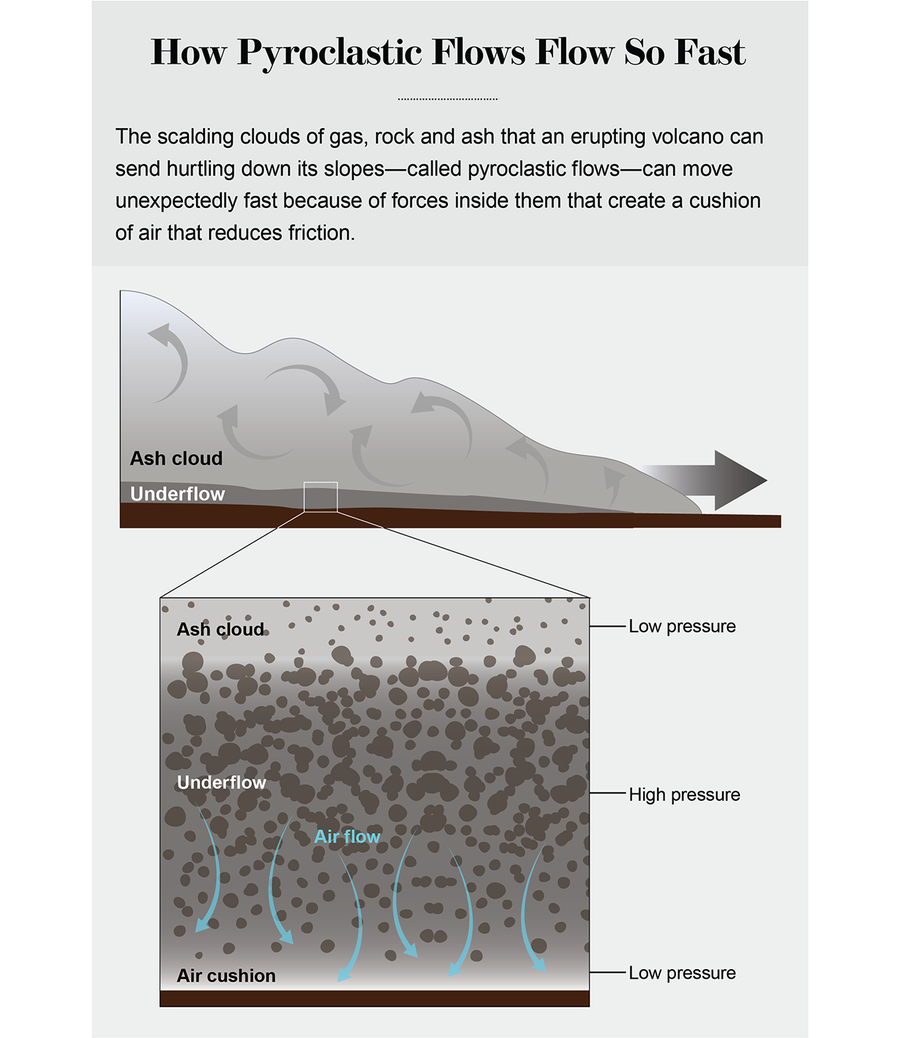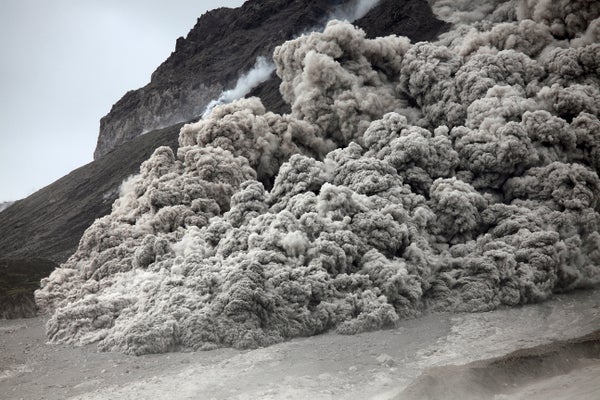When Guatemala’s Volcán de Fuego erupted in June 2018, it sent a billowing hot cloud of gas, ash and rock careening down the slope of the mountain. In the many smartphone videos of the eruption, the rush of debris often looks reassuringly distant—until suddenly it’s not.
How such pyroclastic flows, as they are called, can travel so quickly has long baffled volcanologists and disaster planners alike, leaving communities in volcanically active areas at risk. Now, though, a new study offers an explanation: forces within the flows create a cushion of air, allowing massive amounts of hot rock to slide like a puck on an air hockey table. “It’s a bit like the flow is surfing on something extremely low-friction,” says Gert Lube, a volcanologist at Massey University in New Zealand who led the research.
DIY Volcano
On supporting science journalism
If you're enjoying this article, consider supporting our award-winning journalism by subscribing. By purchasing a subscription you are helping to ensure the future of impactful stories about the discoveries and ideas shaping our world today.
Pyroclastic flows—which can hurtle scalding gases, rock and ash at more than 50 miles per hour—and closely related mudflows called lahars are responsible for half of the deaths caused by volcanoes. They occur abruptly, giving little warning, and people in harm’s way simply don’t expect a material made up of high-friction rock particles to flow as smoothly and quickly as water.

Credit: Melissa Thomas Baum; Sources: “Generation of air lubrication within pyroclastic density currents,” by Gert Lube, et al., and “Travel on thin air,” by Alain Burgisser in Nature Geoscience. Vol. 12 No. 4; April 8, 2019
Last June’s Volcán de Fuego eruption illustrates the danger of misunderstanding a pyroclastic flow. The hot avalanche completely inundated the village of San Miguel Los Lotes, killing at least 200 people. Before the eruption, the town was not thought to be at high risk of a direct hit because it was relatively far from the main potential channel for a pyroclastic flow, says Rudiger Escobar Wolf, a volcanologist at Michigan Technological University who was not involved in Lube’s research. “I’ve worked at the volcano for many years, and I was surprised,” he says.
Escobar Wolf and other hazard researchers use models to try to predict where and how far flows will go in order to map out danger areas. But they cannot measure the physics inside the flows directly, given that a rushing wave of volcanic rock and ash tends to destroy scientific instruments in its path. And small-scale laboratory experiments do not mimic the flows well. That means the existing models have been far from perfect, leaving communities near volcanoes potentially unprepared.
Lube and his team decided to see if scaling up their experiments gave them a better window into what was going on. They used a system akin to a log flume ride that they call PELE—short for pyroclastic flow eruption large-scale experiment. The flume is 12 meters long and half a meter wide. Using a hopper suspended over the flume, the team can drop up to 1,300 kilograms of heated volcanic material down the slope while instruments measure pressure and temperature.
The Fundamentals of Flow
The researchers used material that erupted in the year 232 A.D. from New Zealand’s Taupo volcano, which spread rich sources of pumice and ash conveniently a few hours’ drive from Massey University. They heated the mixture to temperatures ranging from 15 to 130 degrees Celsius. As they tracked the flows down the flume, they noticed that regardless of temperature the material quickly separated into two layers: one a diffuse ash cloud up to 4.5 meters tall and the other a dense base layer 0.8 meter thick.
That base layer held the secret of the pyroclastic flow’s speed. The rapid movement of the volcanic particles creates a strong shear force at the bottom of the layer, which pushes some particles in one direction and others in the parallel but opposite direction, Lube says. The shear results in a zone of low pressure that sucks gases in instead of letting them escape up and out of the flow. This makes for a low-friction slick of gases at the bottom of the pyroclastic flow cloud—a layer that lets the flow really flow.
Lube and his colleagues plugged their experimental results into a computer model of a pyroclastic flow and found that this friction-reducing mechanism also occurs at real-world scales and temperatures of 400 degrees Celsius. “That seems to give us very good confidence that it will occur in pretty much every volcanic flow situation on Earth,” Lube says.
The findings, published Monday in Nature Geoscience, are the first of their kind, says Alain Burgisser, who wrote a commentary published alongside the study. The shear that drives the lubrication process showed up only because of the relatively large scale of the experiment, “which explains why the air cushion was unnoticed until now,” Burgisser says.
Lube is now collaborating with modeling researchers to add these new physics to simulations of pyroclastic flows around the world, so they can compare the results to the actual paths taken by flows in historical eruptions. Local details will matter, Escobar Wolf says. The Taupo ash is different from that found at Volcán de Fuego, for example, and temperatures of real-world pyroclastic flows—which might also affect their behavior—can vary between 200 and 700 degrees C. Nevertheless, the information in the paper could prove very useful for modeling future volcanic hazards. “This experiment may not cover the whole spectrum,” Escobar Wolf says, “but it tells us something fundamental.”
